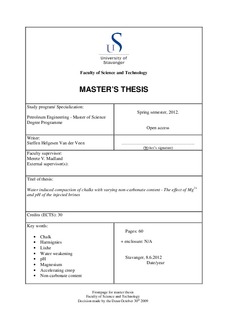| dc.description.abstract | The main objective for this study was to investigate the effect of alkaline brines on chalk, and the importance of non-carbonate content in chalk. This was done by flooding alkaline MgCl2 on Liège chalk – which has non-carbonate content similar to that of North Sea Chalk, in addition to flooding the cleaner Mons chalk using MgCl2 with normal pH (pH≈6). The tests were performed using a triaxial cell, heated to 130°C by a surrounding heating jacket. The chalk cores were initially put under hydrostatic pressure, where the confining pressure was being raised to a desired value (11-12 MPa) simultaneously with increasing piston pressure in axial direction. Prior to this phase, the cores had been flooded with NaCl and gained a pore pressure with a value of 0.7 MPa. After hydrostatic loading, the cores experienced a creep phase. Here, the confining pressure along with pore pressure and piston pressure were kept constant, and it was during this phase that the flooding brines were switched to the desired brines. The only source of discrepancy in creep compaction of the chalk cores was now the injection brine. During creep phase, water samples of the effluent brine were collected for analysis purposes. By doing this, information of what is being produced and retained in the chalk is gained, and one can get a better understanding of the chemical processes that is occurring during this phase.
Four different brines were flooded during these tests. NaCl was used as a pre-flooding brine for all five tests, and as a reference test for one of the Liège chalk cores. Alkaline 0.657 M NaCl and 0.0445 M MgCl2 with equal ionic strength (pH value of 10 and 9.5 respectively) was flooded through Liège chalk cores to further examine the importance of magnesium, and the effect of alkaline flooding. 0.0445 M MgCl2 was selected as this is the magnesium concentration to that found in seawater. 0.219 M MgCl2 was flooded through the Mons core as a reference for the study of calcite purity effects.
During the hydrostatic phase, all four samples showed close to equal total axial strain, with values ranging from 1.05-1.10%. The Mons core seemed to be the strongest chalk with regards to yield strength; 9.9 MPa versus 8.6-9.10 MPa to that of the Liege cores.
During the creep phase, the Liège cores showed some interesting results. When switching from normal to alkaline NaCl, a slight deceleration in creep behavior was immediately observed compared to the reference core flooded with normal pH.
The alkaline 0.0445 M MgCl2 flooded core showed close to equal strain rates of that flooded with alkaline NaCl during the first period of creep; 0.690 and 0.664%/decade respectively. However, after approximately 60 days of creep, the Mg flooded core showed an accelerated creep compaction. This behavior has been seen previously (Madland et al., 2011; Megawati et al., 2011), but at much higher magnesium concentrations (0.219M MgCl2).
The results from the Mons core flooded with 0.219 M MgCl2 indicated that magnesium ions were being retained inside the core along with excessive calcium being produced from the core, causing an enhanced creep compaction observed by an accompanying accelerating creep phase. The same was not seen during the accelerated creep phase for the Liège core. Although there was evidence of both magnesium being retained in the core along with calcium being produced, both the magnesium and calcium concentration seemed to flatten out, indicating that different processes might be occurring during this accelerated creep phase. | no_NO |
